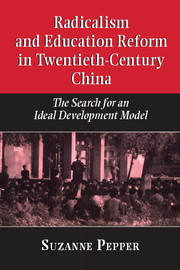Book contents
- Frontmatter
- Contents
- Acknowledgments
- 1 Educational development and the Chinese experience
- Part I The republican era: origins of radical education reform
- Part II Learning from the Soviet Union
- 7 Introducing the Soviet Union
- 8 The Soviet model for Chinese higher education
- 9 Sino-Soviet regularization and school system reform
- 10 Blooming, contending, and criticizing the Soviet model
- Part III Cultural revolution and radical education reform
- Appendix: the Hong Kong interviews
- Select bibliography
- Index
9 - Sino-Soviet regularization and school system reform
Published online by Cambridge University Press: 04 August 2010
- Frontmatter
- Contents
- Acknowledgments
- 1 Educational development and the Chinese experience
- Part I The republican era: origins of radical education reform
- Part II Learning from the Soviet Union
- 7 Introducing the Soviet Union
- 8 The Soviet model for Chinese higher education
- 9 Sino-Soviet regularization and school system reform
- 10 Blooming, contending, and criticizing the Soviet model
- Part III Cultural revolution and radical education reform
- Appendix: the Hong Kong interviews
- Select bibliography
- Index
Summary
Elementary and secondary education reform followed the same course as that at the tertiary level. Initially, features from the mid-io.4os Yan'an past seemed to be carrying over into the new era. Education would “take workers and peasants as the main force and train large numbers of new-style worker-peasant intellectuals.” The First National Conference on Workers’ and Peasants’ Education, in September 1950, promoted the same line. “Different forms and methods may be employed and no forced uniformity or regularity is necessary.” The “people teaching people” concept would be applied until enough regular staff could be trained. But different regions were already issuing provisional regulations which owed far more to their GMD government antecedents than to the post-1942 Yan'an reforms. These regulations, carefully collected and reprinted for general reference, stipulated all the old rules for “raising quality,” complete with provisions for central elementary schools and a few “well-run” middle schools in each locality to serve as leaders and models.
The conflicting aims were written into the first “Decision on School System Reform.” Promulgated on 1 October 1951, the decision marked a kind of transitional attempt to regularize irregularity. It listed the system's defects inherited from the past: lack of formal standing for worker-peasant cadre schools, training classes, etc.; no system of technical education; the division of six-year elementary schooling into separate junior and senior levels. As a result, technical schools were not recognized as part of the regular system, nor were they provided with any regular status; different kinds of training had no rightful place anywhere; and the great majority of rural children who entered elementary school dropped out after the junior level.
- Type
- Chapter
- Information
- Radicalism and Education Reform in 20th-Century ChinaThe Search for an Ideal Development Model, pp. 192 - 216Publisher: Cambridge University PressPrint publication year: 1996



